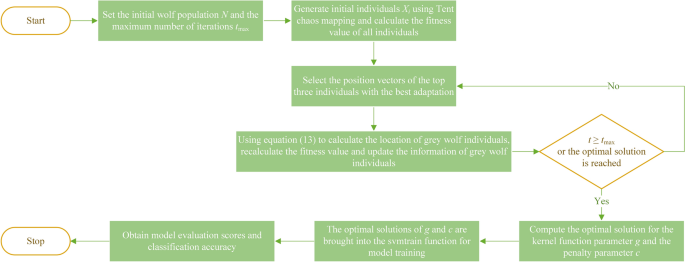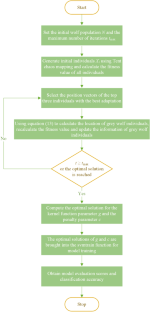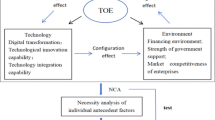Abstract
The green innovation performance (GIP) evaluation helps to identify strengths and weaknesses in regional innovation systems and has been crucial for policymakers in developing appropriate regional policies. Recent methodology has focused on establishing an indicator framework and calculating composite scores. It is noteworthy that the non-linear relationship between evaluation scores and indicators is rarely considered. In view of this, an evaluation model was proposed in the study which combines support vector machine (SVM) and chaotic grey wolf algorithm (CGWO). Sixteen indicators from the indicator system of European Innovation Scoreboard were retained for the GIP evaluation with an initial screening of indicators using the information entropy method. Then, four different types of optimization algorithms were used to optimize the SVM to generate non-linear predictions and GIP scores. The applicability of the model was verified for the GIP evaluation of China’s provinces. According to the training and test results, the SVM-CGWO model achieved significantly better performance than the other three algorithms, which has important benefits in improving the uniformity of the wolf distribution and the traversal of the wolf pack, together with enhancing operation speed and accuracy. It helps users to rank and benchmark regional GIP at the provincial level, taking into account performance improvement and accuracy of dimensions, as well as reliability issues.
Graphical Abstract





Similar content being viewed by others
Data availability
The data that support the findings of this study are available from the corresponding author on reasonable request.
References
Adner R, Kapoor R (2010) Value creation in innovation ecosystems: how the structure of technological interdependence affects firm performance in new technology generations. Strateg Manag J 31(3):306–333
Alameer Z, Elaziz MA, Ewees AA, Ye HW, Zhang JH (2019) Forecasting gold price fluctuations using improved multilayer perceptron neural network and whale optimization algorithm. Resour Policy 61:250–260
Albort-Morant G, Leal-Millán A, Cepeda-Carrión G (2016) The antecedents of green innovation performance: a model of learning and capabilities. J Bus Res 69(11):4912–4917
Ardito L, Dangelico RM (2018) Firm environmental performance under Scrutiny: the role of strategic and organizational orientations. Corp Soc Responsib Environ Manag 25(4):426–440
Barman M, Dev Choudhury NB (2020) A similarity based hybrid GWO-SVM method of power system load forecasting for regional special event days in anomalous load situations in Assam. India Sustain Cities Soc 61:102311
Bian XQ, Zhang L, Du ZM, Chen J, Zhang JY (2018) Prediction of sulfur solubility in supercritical sour gases using grey wolf optimizer-based support vector machine. J Mol Liq 261:431–438
Bielińska-Dusza E, Hamerska M (2021) Methodology for calculating the European Innovation Scoreboard—Proposition for modification. Sustainability 13(4):2199
Bu M, Qiao Z, Liu B (2020) Voluntary environmental regulation and firm innovation in China. Econ Model 89:10–18
Cao S, Nie L, Sun H, Sun W, Taghizadeh-Hesary F (2021) Digital finance, green technological innovation and energy-environmental performance: evidence from China’s regional economies. J Clean Prod 327:129458
Cardoso J (2006) Approaches to developing semantic web services. Int J Comput Sci 1:8–21
Chen P, Yuan L, He Y, Luo S (2016) An improved SVM classifier based on double chains quantum genetic algorithm and its application in analogue circuit diagnosis. Neurocomputing 211:202–211
Chien SC, Wang TY, Lin SL (2010) Application of neuro-fuzzy networks to forecast innovation performance-the example of Taiwanese manufacturing industry. Expert Syst Appl 37(2):1086–1095
Corrente S, Garcia-Bernabeu A, Greco S, Makkonen T (2023) Robust measurement of innovation performances in Europe with a hierarchy of interacting composite indicators. Econ Innov New Technol 32(2):305–322
D’Hondt K, Kostic T, McDowell R, Eudes F, Singh BK, Sarkar S, Markakis M, Schelkle B, Maguin E, Sessitsch A (2021) Microbiome innovations for a sustainable future. Nat Microbiol 6:138–142
Dabbous A, Tarhini A (2021) Does sharing economy promote sustainable economic development and energy efficiency? Evidence from OECD countries. J Innov Knowl 6(1):58–68
Dai YF, Chu PY, Lu ST, Chen WT, Tien YC (2022) Evaluation of regional innovation capability: an empirical study on major metropolitan areas in Taiwan. Technol Econ Dev Econ 28:1–37
Djemai S, Brahmi B, Bibi MO (2016) A primal–dual method for SVM training. Neurocomputing 211:34–40
Drejer I (2004) Identifying innovation in surveys of services: a Schumpeterian perspective. Res Policy 33(3):551–562
Duan L, Hongxin Z, Khan MS, Fang M (2017) Recognition of motor imagery tasks for BCI using CSP and chaotic PSO twin SVM. J China Univ Posts Telecommun 24(3):83–90
Dziallas M, Blind K (2019) Innovation indicators throughout the innovation process: an extensive literature analysis. Technovation 80–81:3–29
Edquist C, Zabala-Iturriagagoitia JM, Barbero J, Zofío JL (2018) On the meaning of innovation performance: Is the synthetic indicator of the Innovation Union Scoreboard flawed? Res Eval 27(3):196–211
Ernest B, David W (1994) Regulation as a means for the social control of technology. Techn Anal Strat Manag 6:259–327
Fernando Y, Wah WX (2017) The impact of eco-innovation drivers on environmental performance: Empirical results from the green technology sector in Malaysia. Sust Prod Consump 12:27–43
Ghazinoory S, Riahi P, Azar A, Miremadi T (2014) Measuring innovation performance of developing regions: learning and catch-up in provinces of Iran. Technol Econ Dev Econ 20(3):507–533
Gupta H, Barua MK (2018) A grey DEMATEL-based approach for modeling enablers of green innovation in manufacturing organizations. Environ Sci Pollut Res 25(10):9556–9578
Hajek P, Henriques R (2017) Modelling innovation performance of European regions using multi-output neural networks. PLoS ONE 12(10):e0185755
Han L, Han LY, Zhao H (2013) Orthogonal support vector machine for credit scoring. Eng Appl Artif Intell 26(2):848–862
Hollanders H (2021) European innovation scoreboard 2021: main report. European Commission, Brussels
Huang X, Shi L, Suykens JAK (2015) Sequential minimal optimization for SVM with pinball loss. Neurocomputing 149:1596–1603
Huang S, Zheng X, Ma L, Wang H, Huang Q, Leng G, Meng E, Guo Y (2020) Quantitative contribution of climate change and human activities to vegetation cover variations based on GA-SVM model. J Hydrol 584:124687
Iansiti M, Levien R (2004) Strategy as ecology. Harv Bus Rev 82(3):68–78
Jiang H, Liu G, Alyami H, Alharbi A, Jameel M, Khadimallah MA (2022) Intelligence decision mechanism for prediction of compressive strength of self-compaction green concrete via neural network. J Clean Prod 340:130580
Kaur V, Mehta V (2017) Dynamic capabilities for competitive advantage: a comparative study of IT multinationals in India. Paradigm 21(1):31–51
Lakum A, Mahajan V (2021) A novel approach for optimal placement and sizing of active power filters in radial distribution system with nonlinear distributed generation using adaptive grey wolf optimizer. Eng Sci Techn Int J 24(4):911–924
Li DY, Zheng M, Cao CC, Chen XH, Ren SG, Huang M (2017) The impact of legitimacy pressure and corporate profitability on green innovation: evidence from China top 100. J Clean Prod 141(2):41–49
Liu D, Li M, Ji Y, Fu Q, Li M, Abrar Faiz M, Ali S, Li T, Cui S, Imran Khan M (2021a) Spatial-temporal characteristics analysis of water resource system resilience in irrigation areas based on a support vector machine model optimized by the modified gray wolf algorithm. J Hydrol 597:125758
Liu L, Zhao Z, Su B, Ng TS, Zhang M, Qi L (2021b) Structural breakpoints in the relationship between outward foreign direct investment and green innovation: an empirical study in China. Energy Econ 103:105578
Melande L (2017) Achieving sustainable development by collaborating in green product innovation. Bus Strateg Environ 26(8):1095–1109
Miao CL, Fang DB, Sun LY, Luo QL (2017) Natural resources utilization efficiency under the influence of green technological innovation. Resour Conserv Recycl 126(11):153–161
Michelino F, Cammarano A, Celone A, Caputo M (2019) The linkage between sustainability and innovation performance in IT hardware sector. Sustainability 11(16):4275
Mirjalili S, Mirjalili SM, Lewis A (2014) Grey wolf optimizer. Adv Eng Softw 69:46–61
Peltier JW, Dahl AJ, Swan EL (2020) Digital information flows across a B2C/C2C continuum and technological innovations in service ecosystems: a service-dominant logic perspective. J Bus Res 121:724–734
Peng W, Yin Y, Kuang C, Wen Z, Kuang J (2021) Spatial spillover effect of green innovation on economic development quality in China: evidence from a panel data of 270 prefecture-level and above cities. Sustain Cities Soc 69:102863
Ponta L, Puliga G, Manzini R (2021) A measure of innovation performance: the innovation patent index. Manag Dec 59(13):73–98
Rajapathirana RJ, Hui Y (2018) Relationship between innovation capability, innovation type, and firm performance. J Innov Knowl 3(1):44–55
Saremi S, Mirjalili SZ, Mirjalili SM (2015) Evolutionary population dynamics and grey wolf optimizer. Neural Comput Appl 26(5):1257–1263
Saunila M, Ukko J, Rantala T (2018) Sustainability as a driver of green innovation investment and exploitation. J Clean Prod 179:631–641
Shen C, Li S, Wang X, Liao Z (2020) The effect of environmental policy tools on regional green innovation: evidence from China. J Clean Prod 254:120122
Son K, Lee SW, Yoon W, Hyun KH (2022) Creative Search: proactive design exploration system with Bayesian information gain and information entropy. Autom Constr 142:104502
Song W, Han X (2022) The bilateral effects of foreign direct investment on green innovation efficiency: evidence from 30 Chinese provinces. Energy 261:125332
Sun Y, Xu J (2021) Evaluation model and empirical research on the green innovation capability of manufacturing enterprises from the perspective of ecological niche. Sustainability 13(21):11710
Takalo SK, Tooranloo HS, Parizi ZS (2021) Green innovation: a systematic literature review. J Clean Prod 279(2):122474
Tan F, Gong C, Niu Z (2022) How does regional integration development affect green innovation? Evidence from China’s major urban agglomerations. J Clean Prod 379:134613
Tang Z, Guo S, Li P, Miyazaki T, Jin H, Liao X (2015) Energy-efficient transmission scheduling in mobile phones using machine learning and participatory sensing. IEEE Trans Veh Technol 64(7):3167–3176
Teece DJ (2014) A dynamic capabilities-based entrepreneurial theory of the multinational enterprise. J Int Bus Stud 45(1):8–37
Tellis GJ, Chandy RK, Prabhu JC (2012) Key questions on innovation in the B2B context. In: Lilien GL, Grewal R (eds) Handbook of business-to-business marketing. Edward Elgar Publishing, Cheltenham, pp 582–595
Tian H, Li Y, Zhang Y (2022) Digital and intelligent empowerment: can big data capability drive green process innovation of manufacturing enterprises? J Clean Prod 377:134261
Vapnik V, Levin E, Cun YL (1994) Measuring the VC-dimension of a learning machine. Neural Comput 6(5):851–876
Vasileiou E, Georgantzis N, Attanasi G, Llerena P (2022) Green innovation and financial performance: a study on Italian firms. Res Policy 51(6):104530
Wang CM, Li J (2020) The evaluation and promotion path of green innovation performance in Chinese pollution-intensive industry. Sustainability 12(10):4198
Wang J, Zhao L, Zhu R (2022a) Peer effect on green innovation: evidence from 782 manufacturing firms in China. J Clean Prod 380:134923
Wang T, Ding Y, Gao K, Sun R, Wen C, Yan B (2022b) Toward sustainable development: Unleashing the mechanism among international technology spillover, institutional quality, and green innovation capability. Front Psychol. https://doi.org/10.3389/fpsyg.2022.912355
Wang XY, Khurshid A, Qayyum S, Calin AC (2022c) The role of green innovations, environmental policies and carbon taxes in achieving the sustainable development goals of carbon neutrality. Environ Sci Pollut Res 29:8393–8407
Wu WH, Wu WZ, Wu KH, Ding C (2022) The nexus between green innovations and natural resources commodity prices in China. Resour Policy 78:102719
Yang H, Li L, Liu Y (2022) The effect of manufacturing intelligence on green innovation performance in China. Technol Forecast Soc Chang 178:121569
Yu Z, Shen Y, Jiang S (2022) The effects of corporate governance uncertainty on state-owned enterprises’ green innovation in China: Perspective from the participation of non-state-owned shareholders. Energy Econ 115:106402
Yusr MM, Salimon MG, Mokhtar SSM, Abaid WMAW, Shaari H, Perumal S, Saoula O (2020) Green innovation performance! How to be achieved? A study applied on Malaysian manufacturing sector. Sust Futures 2:100040
Zeng J, Chen X, Liu Y, Cui R, Zhao P (2022) How does the enterprise green innovation ecosystem collaborative evolve? Evidence from China. J Clean Prod 375:134181
Zhao N, Liu X, Pan C, Wang C (2021) The performance of green innovation: from an efficiency perspective. Socioecon Plann Sci 78:101062
Zhou T, Lu HL, Wang WW, Yong X (2019) GA-SVM based feature selection and parameter optimization in hospitalization expense modeling. Appl Soft Comput 75:323–332
Acknowledgements
This work was supported by the Social Science Planning Fund of Chongqing [Grant Number 2021NDYB046], and Humanities and Social Sciences Research Project of Chongqing Municipal Education Commission [Grant Number 23SKGH167]. We thank LetPub (www.letpub.com) for its linguistic assistance during the preparation of this manuscript.
Author information
Authors and Affiliations
Contributions
Pengyi Zhao involved in data curation, methodology, writing- original draft preparation. Yuanying Cai involved in data curation, software, writing-reviewing and editing. Liwen Chen involved in validation, writing-reviewing and editing. Qing Li involved in writing-reviewing and editing. Fuqiang Dai involved in supervision, methodology, writing-reviewing and editing.
Corresponding author
Ethics declarations
Conflict of interest
The authors declare that they have no known competing financial interests or personal relationships that could have appeared to influence the work reported in this paper.
Additional information
Publisher's Note
Springer Nature remains neutral with regard to jurisdictional claims in published maps and institutional affiliations.
Rights and permissions
Springer Nature or its licensor (e.g. a society or other partner) holds exclusive rights to this article under a publishing agreement with the author(s) or other rightsholder(s); author self-archiving of the accepted manuscript version of this article is solely governed by the terms of such publishing agreement and applicable law.
About this article
Cite this article
Zhao, P., Cai, Y., Chen, L. et al. Evaluation of regional green innovation performance in China using a support vector machine-based model optimized by the chaotic grey wolf algorithm. Clean Techn Environ Policy (2024). https://doi.org/10.1007/s10098-024-02867-2
Received:
Accepted:
Published:
DOI: https://doi.org/10.1007/s10098-024-02867-2




